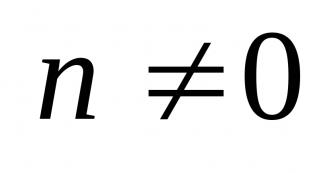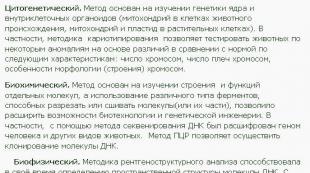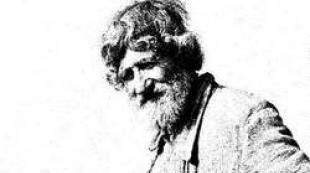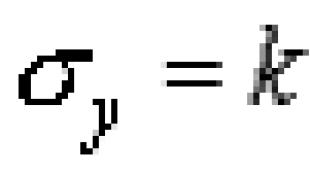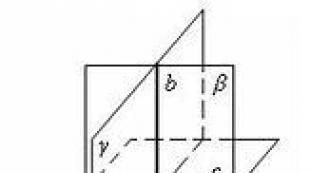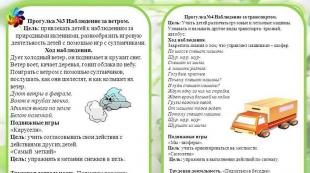Who lives where wild and domestic animals. Forest animals, abstract of a lesson on familiarization with nature. Game "Who lives where"
Didactic games for kindergarten on the topic: "Animals"
Author: Knis Anna Nikolaevna, senior teacher.
Place of employment: MBDOU "Kindergarten No. 3 "Smile", Kalach-on-Don.
Description of work: I bring to your attention didactic games for preschoolers on the topic: "Animals". This material will help educators, children and their parents to consolidate children's knowledge about wild and domestic animals, their cubs in a playful way.
Didactic game: lotto "Animals".

Target: Consolidation of children's knowledge about animals, the ability to distinguish and find the right animal.
Didactic material: The playing field (4 pcs.), Divided into 6 squares with images of various animals corresponding to the images on small cards (24 pcs.).





Game progress: Game for children from 3 years old. The game can be played by 3-5 people. Players are given game cards. The host pulls out a small card from a special opaque bag, the player or host calls the animal. Whoever found the corresponding image on his field takes the picture for himself. This continues until one of the participants covers the entire playing field with chips. For children from 5 years old, the game can be complicated. Name the animals depicted on the same playing field in one word.
On the first field are depicted: a cat, a pig, a horse, a cow, a goat, a sheep. These are pets.
On the second field are depicted: deer, squirrel, elk, fox, wild boar, wolf. These are forest animals.
On the third field are depicted: sloth, echidna, platypus, kiwi, iguana, koala. These are Australian animals.
On the fourth field are depicted: a lion, a rhinoceros, a giraffe, a camel, an elephant, a zebra. These are the animals of Africa.
Didactic game "Who lives where?"
Target: Formation of children's skills to correlate the image of animals with their habitat.
Didactic material: Cards with the image of animals 24 pieces (we take from the loto) and two playing fields with the image of a forest and a village.


Game progress: Lay out the cards according to the habitats of animals, domestic in the village, and wild in the forest.
Didactic game "Guess what kind of animal"
Target: Development of the ability to describe animals and recognize them by description.
Didactic material: Animal cards.
Game progress: The teacher gives the children cards with the image of animals. Children do not show their cards to anyone. The teacher offers one child to describe the animal depicted in his picture, or to make a riddle about him. Other children must guess what animal it is.
Didactic game "Collect a picture"
Target: Development of logical thinking, outlook, cognitive interest and speech activity.
Didactic material: Cards with the image of animals, cut into several parts.
Game progress: Game for children from 3 years old. Children are given playing cards cut into 2, 3, 4 parts (according to the age and abilities of the child). Having collected the picture, the child tells what animal he has collected.
For example: A dog is a pet.
The bear is a wild animal.
Didactic game "The fifth extra"
Target: Development of skills to classify animals according to essential features.
Didactic material: Cards with the image of 5 animals, 4 of them belong to one thematic group, and the fifth to another group.
Game progress: The children are given the task: “Look at the pictures, name what is shown on them and determine which animal is superfluous. Name the remaining animals in one word. Each participant eliminates the extra animal in turn. If he makes a mistake or does not complete the task, his version is offered to the next player. For each correctly completed task, they give a chip. The one with the most chips wins.
Cards for the game:
1. Cat, fox, squirrel, wolf, bear. Extra porridge because it is a domestic animal, and the rest are wild animals.

2. Deer, tiger, dog, fox, lion. An extra dog because it is a pet and the rest are wild animals.

3.Pig, sheep, dog, fox, cat. An extra fox because it is a wild animal, and the rest are domestic animals.

4. Horse, zebra, cow, donkey, goat. An extra zebra because it is a wild animal, and the rest are domestic animals.

Didactic game "Whose Tail"
Target: Development of attention, logic, memory, fine motor skills.
Didactic material: Cards with the image of various animals, as well as their tails.
Game progress: The child is given a task. Pick up a tail for each animal and connect the desired pictures with lines. Name which animal has which tail (long, short, fluffy, thick, small, large, etc.).

Didactic game "Whose baby"
Target: Development of observation, attention and analytical skills.
Didactic material: 12 baby animal cards and 2 game boards featuring wild and domestic animals.
Game progress: The children have to help mothers find their babies. Also, when playing, you can fix the concept of big and small, domestic and wild animals in kids. The game can be played from one to four people.



Didactic game "Whose shadow"
Target: Development of logic, thinking and visual memory.
Didactic material: Cards with the image of various animals, as well as their shadows.
Game progress: Invite the child to find where whose shadow is and connect the necessary pictures with lines.

Didactic game "What animals hid in the picture?"
Target: Development of attention, thinking, imagination.
Didactic material: Cards showing the outline of various animals.
Game progress: Invite the child to find and name the animals drawn in the picture.
Performed:
primary school teacher
MOU ITL No. 24 im. E. A. Varshavsky
Khitrova Anastasia Sergeevna
Neryungri 2016
Target: Generalize and systematize children's knowledge about the life of domestic and wild animals
Tasks:
- Educational: Continue to clarify and systematize children's ideas about the life of domestic and wild animals; to know and highlight the essential features of animals, to know: what they eat, how they give a voice, where they live, what benefits they bring to a person; improvement of the grammatical structure of speech.
- Developing: Develop coherent speech; expand vocabulary, develop imagination, curiosity, memory and thinking of children.
- Educational: Education of independence, activity, initiative, respect for animals; a sense of camaraderie.
Equipment: Presentation, tokens, diploma "Wildlife experts".
During the classes
The students sit in groups of three. For the correct answer and the completed task, the team receives a token. At the end of the lesson, the team that has collected the most tokens is awarded a diploma "Wildlife Experts".
1. Introduction
A variety of animals live in the world around us.
They are different in size, color, they move in different ways. What?
(Run, crawl, fly)
They make different sounds. Which?
(Barking, mooing, croaking...)
We know that animals that live next to humans are called...?
(Homemade)
What are the names of animals that live on their own?
2. Goal setting
Today, guys, we have not just a lesson, but a quiz lesson. We will remember and consolidate our knowledge about animals. For correct and interesting answers you will be rewarded with tokens, and at the end of the lesson we will sum up our quiz.
So, let's begin.
Choose an interesting name for your team.
(children choose)
3. The game "Who lives where"
(The blackboard shows a picture of nature. a tree, a lake, a cobweb under the branches on a tree, a meadow with grass, flowers. The teacher reads riddles about animals to the children. Children guess, take the image of the animal and place it in the place in the picture where this animal lives. )
Look at the blackboard. What a beautiful picture! But is someone missing? Whom?
(Inhabitants)
Right! Without residents, this picture looks empty. Let's put her in. I will read riddles to you. The first team to raise their hands answers. If the answer is correct, then one participant goes out, takes a picture with a guessed animal and attaches it to the board in the place where this animal lives.
A ball of fur was winding in the forest,
What made the animals laugh.
And you take it and guess
Who made everyone laugh? Certainly, … .
(BUNNY) - fasten under a tree.
The file will be here: /data/edu/files/o1460902105.pptx (wild and domestic animals)
A flock of birds are circling in the sky,
Flock, not at all simple!
Do not beat this one:
I flock gray ... .
(DOVE) - fasten to the sky.
There is minnow, crucian carp, bleak,
Eel, roach and roach.
But you can tell us
In one word, all words.
(FISH) - we fix it in the lake.
She lives in our barn,
Chews both hay and grass,
And gives milk to drink.
So who will call me?
(COW) - fasten to the meadow.
Like a fisherman he weaves a net,
And he doesn't go fishing.
(SPIDER) - fasten to the web.
I once saw in the forest
Dark red beauty.
She jumped on the branches
Apparently she was looking for bumps there.
(PROTEIN) - fasten to a tree branch.
Above the beetle and bark beetle
He always wins.
Knock and knock on the trees:
Who is a true friend for the forest?
(Woodpecker) - fasten to a tree trunk.
Well done! I see you know well where the animals live.
2. The game "Who said?"
We all know how and love to communicate with each other. Do you think animals talk to each other?
Of course, animals, just like people, can communicate with each other. Let's listen to recordings of the voices of various animals and try to guess which animal makes such sounds.
(According to the audio recording, the children should name the animal that makes such sounds)
3. "Whose house?"
Guys, do you think pets live in the house with a person or on the street?
(Children's guesses)
Some animals, such as a dog with a cat, or hamsters and parrots, live in a house with a person. But what about large pets? After all, it is impossible to take a cow or a horse into the house with you.
(Children's guesses)
People build houses for pets.
For example, a house for cows is called a barn. For rabbits - a rabbitry, for pigs - a pigsty, for chickens - a chicken coop. If cows, goats, and sheep live in one large room, then such a room is called a barn.
Where do wild animals live?
Look at the diagram. A member of each team in turn goes out and connects the animal and its house with a line.
(Scheme on the board)
beaver hole
bear lair
fox dam
lair squirrel
wolf anthill
ant hollow
4. Quiz "Who am I?"
All animals are different. Someone is shaggy, and someone with horns, someone loves honey, and someone likes caterpillars. Let's try to guess from the description who we are talking about.
■ “I am very large, about two meters tall, and my weight is 350 kg. I have brown hair, small ears and a tail. I can walk on my hind legs and climb trees in search of food. And I eat fish, berries, I can eat ants, worms and beetle larvae. I spend the whole winter hibernating, and in the spring I leave the lair thin, hungry and angry. (Bear.)
■ “I live in the Far North. I eat fish and seals. I love the sea very much. A thick layer of fat under the skin and a long white coat protect me from hypothermia. And my paws are like flippers, so I'm a good swimmer and I'm not afraid to swim far into the sea. (Polar bear.)
■ “I have a sharp muzzle, erect ears, a very finely developed sense of smell. I am very greedy. I eat meat, attacking deer, elk, rodents, but sometimes, when I can’t find anything, I survive on plant food - berries. I like to hunt at night, alone. Sometimes I chase prey for hours, running not a single kilometer. But in winter, in order to feed ourselves, we gather in flocks. (Wolf.)
■ “I am a fat funny animal with sharp front teeth. My house is called a hut. I choose a small river or stream with running water as a place for my hut. I cut tree branches with my teeth and build a dam out of them to keep the water at a constant level and always have an underwater connection with the dwelling. There are two “rooms” in the hut: a bedroom and a pantry. (Beaver, or beaver.)
■ “I have a very keen sense of smell. My biggest treat is field mice. A mouse squeaks a little - and I can hear it from a hundred meters away, even in winter, when it hides under the snow. I can eat up to 20 of them a day. I hunt at night, and during the day I like to relax. Often they call me a red cheat. (Fox.)
■ “I live with my family in a burrow that I dug with my front paws and lined with soft grass and down. I am very careful. Before approaching the mink, I will make a few jumps to the side, then a few jumps to the other side, and only then do I jump into my house. In winter, in order to be invisible in the snow, I change my fur coat. (Hare.)
■ “I have very beautiful antlers, but every winter I have to shed them. The body is covered with beautiful small light specks. Wool protects well from frost, and wide hooves do not allow me to fall through the snow. I pride myself on good eyesight, and my hearing and sense of smell allow me to detect danger without much difficulty. (Deer.)
■ “I look like a clumsy fat mouse with big cheeks. I have round shiny eyes, short legs and a pointed little tail.
I build a mink at a depth of 1-2 meters underground, which consists of several "rooms": in one I sleep in the winter, and in the other I store supplies. Sometimes they keep me at home, in a cage.” (Hamster.)
■ “I, small and gray, build myself a mink either in a field or in a forest, under the roots of trees in a secluded place. My mink is like a bird's nest. Here I store seeds, berries, nuts, dry buds and roots of herbs and trees. In winter, I often go out of my mink to replenish my supplies. To do this, I dig special tunnels and move along them. (Mouse.)
■ “I, a kind fussy little animal, live everywhere. I have a long fluffy tail and beady eyes. The tail, almost equal to the length of my body (about 20 cm), serves as a pole and an umbrella for me, allowing me to maintain balance and jump along the branches. There are small tassels on the ears that protect my ears from frost. On severe frosty days, I sit in a hollow and eat acorns, dry mushrooms, nuts. (Squirrel)
■ “I am a small animal with velvety dark gray fur. I have strong front paws, like large shoulder blades. Claws grow on them, with which I dig the earth and throw it back. I have eyes, but they are just tiny beads covered in fur and skin. I don't need eyes, as I constantly live underground in pitch darkness. But I have a great sense of smell. I can smell an earthworm from a few meters away.” (Mole.)
5. Physical Minute
Antipka the cat lived with us. (Stand up, hands on the belt.)
He got up from his bed at one o'clock. (Stretch, hands up - inhale.)
At two in the kitchen he stole sausages (Tilts left and right.)
At three he ate sour cream from a bowl. (Tilts forward, hands on the belt.)
He washed at four. (Tilts of the head to the shoulders to the left and right.)
Rolled on the mat at five. (Turns left and right.)
At six he dragged herring from the tub. (Jerking hands in front of the chest.)
At seven he played hide-and-seek with the mice. (Claps front-back.)
At eight slyly screwed up his eyes. (Squats.)
At nine ate and listened to fairy tales. (Clap hands.)
At ten I went to the couch to sleep, (Jumping in place.)
Because you have to get up at one o'clock. (We walk in place.)
6. Quiz "Who benefits"
Guys, why do you think a person needs pets?
(children's guesses)
It is true, from them we get things useful for our life. Milk, wool, meat and more.
Let's try to guess which animal gives us what.
(teacher shows slides with images, children guess the animal)
Slides 18-22
I love pets very much.
I feed, caress and caress
Dog and cat, goat and pig
I consider my friends.
Cow, goat give us milk,
There is no sheep's wool,
A purring cat will give us comfort
And catch all the mice.
Our helpers are a cow, a ram
And a black horse, dark-maned
Live next to us, attached to us,
Confident, peaceful.
7. Cartoons
Do you listen and watch fairy tales and cartoons attentively? We will now verify this by conducting a comic quiz.
For each correct answer, teams receive 1 token.
Where did Winnie the Pooh find Eeyore's tail? (On the door at the Owl)
Who got Winnie the Pooh stuck in the door? (At the Rabbit)
The name of Malvina's favorite dog from the fairy tale "The Adventure of Pinocchio"? (Artemon)
What was the ransom for Mowgli's life? (Buffalo)
Who did Alice follow in Wonderland? (Behind the rabbit)
Whom did the little robber give to help Gerda? (deer)
Who sings a song: "I'm lying in the sun ..."? (Turtle and lion cub)
What is the favorite expression of Leopold the cat. ("Guys let's be friends")
38 parrots and 1 wing is the length of who? (Boa constrictor)
“He who visits in the morning, he acts wisely ...” Whose words are these? (Winnie the Pooh)
What was the name of the turtle from the fairy tale "The Adventure of Pinocchio" (Tortilla)
What is the name of the fairy-tale hero who has big ears? (Cheburashka)
To whom was the mammoth in a hurry? (To Mom)
This terrible beast ate the fabulous Little Red Riding Hood along with her grandmother (Wolf)
What was the name of Ellie's dog from The Wizard of Oz? (Totoshka)
8. Whose announcement?
Guys, I got my hands on a newspaper with so many ads! But here's the problem! It is not specified who is the author of this ad! Let's help readers and for each ad we will find its author.
you have envelopes with pictures of animals on your tables. Take them out. I read the ad, and you hold up the card of the animal you think is the author. A badge for a correct answer!
1. Friends! Who needs needles, please contact me. (Hedgehog)
2. Help wake me up in spring. Come better with honey. (Bear.)
3. I am the most charming and attractive! Whoever you want to deceive, I will circle around your finger. Given all this, I urge you to call me by my first name and patronymic. Do not call Patrikeevna any more! (Fox)
4. It became very boring to howl at the moon alone. Who will keep me company? (Wolf.)
5. Everyone, everyone, everyone! Who has a need for horns. Contact me once a year. (Elk.)
6. I teach all sciences! From chicks in a short time I make birds. Please note that classes are held at night. (Owl.)
7. I can help kind, but lonely birds to find family happiness! Hatch my chicks! I have never experienced maternal feelings and never will. I wish you happiness in your personal life. (Cuckoo.)
8. To the one who finds my tail! Leave it as a memento. I am successfully growing a new one. (Lizard.)
9. I have been waiting for a friend for 150 years! The character is positive. There is only one drawback - slowness. (Turtle.)
9. Summing up.
Today all of you were great fellows! I see you know both domestic and wild animals very well. And now it's time to count the tokens and get rewards.
Goals:
Enrich children's ideas about forest animals (note the characteristic features of animal representatives).
Teach children to come up with the simplest comparative turns.
Introduce the words into the children's active dictionary: animals, wolf's den. Teach children to perform movements in accordance with the text of the poem.
Develop creative imagination: depict the habits of animals, imitate the movements of animals - the heroes of the poem.
To consolidate the skills of painting with colored pencils and drawing in the missing details of the image.
Continue to teach children to solve riddles.
Develop thinking, fine motor skills of hands.
Cultivate an interest in wildlife.
Equipment:
Pictures with the image of a fox, a bear, a wolf, a hare, an owl.
Scheme: a rectangular sheet of paper divided into four equal squares (horizontally); 1 - four paws, 2 - muzzle, 3 - tail, 4 - wool.
Equipment for drawing with colored pencils.
Sheets of paper with painted animals (a fox without a tail, a hare without ears, a bear without paws).
Preliminary work:
Offer the children a board-printed puzzle game "Who lives in the forest."
Reading a poem
At the fox in the deaf forest
There is a hole - a safe house.
Snowstorms are not terrible in winter
A squirrel in a hollow by a spruce.
Under the bushes prickly hedgehog
Heaps up the leaves.
Sleeping in a lair clubfoot,
Until spring, he sucks his paw.
Everyone has their own home
Everyone is warm and comfortable in it.
Lesson progress:
Guys. Look at these pictures, think and tell me who is superfluous here? Why? Because an owl is a bird, and all other animals, or better to say, are animals. Let's repeat this word and remember it. Animals.
Animals mean alive. All animals have four legs, a tail, a muzzle, and the body is covered with hair. Look at this diagram. (Scheme display). It depicts something that will always help you determine whether it is an animal or not. How many paws are shown in the first box? Four paws. What is shown in the second window? Tail. In the third window? Muzzle. Animals have a muzzle, and a person has ... a face. And in the last window, wool is depicted. And if instead of wool the body is covered with feathers. Is it an animal or not? Who? Bird.
Let's play this game. I'll call. And you answer: an animal or not.
Didactic exercise "Identify the animal"
Bear
Squirrel
Frog
Hare
Sparrow
Snake
Fox
Wolf
Dolphin
Mouse
We remove the picture with the owl and name which animals are depicted in these pictures.
And now I will arrange these pictures in different corners of the group room. Listen to the riddle and run to the riddle.
Didactic game "Find a clue"
Who lives in the forest deaf,
Clumsy, clumsy?
In the summer he eats raspberries, honey,
And in winter he sucks his paw.
(Bear)
Higher cat growth,
Lives in a hole in the forest
Fluffy red tail
We all know...
(Lisu)
What kind of beast in cold winter
Walking through the woods hungry?
He looks like a dog
Every tooth is a sharp knife!
He runs, baring his mouth,
Ready to attack the sheep.
(Wolf)
Rushing without looking back
Only heels sparkle.
It rushes that there is a spirit,
The tail is shorter than the ear.
All animals are scared
Saved under a bush
Yes, the wolf comes across the tooth.
(Hare)
Who deftly jumps on the trees
And flies up to the oaks?
Who hides nuts in a hollow,
Dry mushrooms for the winter?
(Squirrel)
Do all these animals live in the city next to us? Tell me, please, where can you see these animals in the city? At the zoo, at the circus. Where do bear, hare, wolf and fox live? These animals live in the forest, which is why they are called forest animals.
All forest dwellers live like one big forest family, which has its own rules. And everyone obeys them. Because they depend on each other, they cannot live without each other.
Guys, do you have a house where you live with your family? Are there houses in the forest? Where do forest animals live?
Each animal has its own home in the forest. Only these houses are different. Wherever it is convenient for anyone, they live there.
Didactic game "Who lives where"
Bear - ... in a den.
Fox - ... in a hole.
Hare - ... under a bush.
Squirrel - ... in the hollow.
A wolf's house is called a lair.
Repeat - "wolf's lair" and remember.
Each animal has its own character. Yes, you yourself know this very well.
Didactic exercise "Who is what"
Angry, like... a wolf.
Cowardly, like ... a hare.
Sly as ... a fox.
Clubfoot, like... a bear.
Toothy, like ... a wolf.
Fluffy, like ... a hare.
Clumsy, like... a bear.
Jumping like... a squirrel.
Dynamic pause "Animal Charge"
(Based on a poem by A. Barto) Children perform movements in accordance with the text of the poem.
Once - an oath.
Two is a jump.
This is a rabbit load.
And the foxes how to wake up
They love to stretch
Be sure to yawn
Well, wag your tail.
And the wolf cubs bend their backs
And jump lightly.
Well, the bear is clubfoot,
Paws wide apart:
One, then both together
Long time treading water.
And for whom charging is not enough -
Let's start all over again!
Drawing "Forest animals"
Guys, do you have pictures to color. Who is depicted on them? Is the drawing finished? What did the artist not finish? Your task: to finish the fox - the tail, the bear - the paws, the hare - the ears. (Showing work done, children's work).
Then color in the picture of the animals. What color will we paint the fox? Bear? Hare? You need to paint evenly, with small strokes, try not to go beyond the outline of the image.
And what needs to be drawn in order to make it clear - these are forest animals. You need to draw trees, a forest. Like this. (Showing the drawing of a tree). But if we draw only one tree, then it will not look like a forest. So draw some trees. Evaluation of children's work.
What should a preschooler know about animals? Firstly, it is a wild animal or a domestic animal, an animal of the forest, the north or Africa, that is, a habitat. Secondly, in what "house" does the animal live, if it is wild: it can be a hole, a lair, a hollow, or the animal does not make a house for itself at all. Thirdly, what does this animal eat. An engaging story is just what you need. And be sure to accompany this story about animals with pictures, because we know that visual memory helps a lot in teaching a preschooler. We will talk with the child about wild animals and show cards - mnemonic tables, so the kids will be better interested in the topic and remember all the details visually, figuratively.
wild animals of the forest
Hare
The hare lives in the forest. He does not dig holes for himself, but hides in the bushes, in the recesses under the roots, under the branches, and there they build a winter hut for themselves. The main food of a hare is grass, hay, young tree branches. The hare eats vegetables, fruits and berries, if they can be found.
Fox
The fox is a wild animal. She lives in the forest, in a hole. The fox is a predatory animal. The main food of foxes is insects (beetles, earthworms) and small rodents (vole mice). If the fox manages to catch a hare or a bird, which does not happen very often, she will eat them with pleasure. Often foxes settle next to a person and steal poultry from poultry houses. Sometimes it can also eat fish thrown ashore. It will not disdain berries and fruits when it is hungry.

Wolf
The wolf is an animal of the forest. Wolves live in dens. Wolves hunt in packs, so they can catch large prey: elk, deer. With pleasure, the wolf and the bird, and the bunny will be treated. In famine years, wolves may attack livestock, but this is very rare. Wolves are very cautious and afraid of humans.

Hedgehog
Hedgehogs live in the forest. They rarely dig holes themselves, more often they occupy strangers or build a nest among protruding roots, under a bush, in the recesses of the earth, dragging a lot of leaves, dry grass and moss into it. In winter, hedgehogs hibernate. Hedgehogs eat mostly insects. If a snake is caught, they can eat it too. Do not mind eating mushrooms, acorns, berries and fruits.

Brown bear
The brown bear is a wild animal of the forest. For the winter, the bear builds a lair for itself and hibernates. The main food of bears is berries, roots, mushrooms. If a bear finds a bird's nest - it will eat eggs, if it finds a hive of wild bees - it will eat honey. The bear knows how to catch fish and eats it with pleasure. It can also eat a mouse if it can be caught. Do not disdain and carrion.

Squirrel
The squirrel lives in the forest. She finds a hollow in a tree and settles there. The squirrel eats berries, fruits, mushrooms, nuts, acorns and grains. Stores supplies for the winter, hiding them under roots or among tree branches so as not to starve in winter.

desert animals
Camel
Camels live in the desert and semi-desert. They don't build houses. They feed on grass (both dry and fresh), tree twigs, camel thorn, ephedra, wormwood, chew saxaul branches. The camel accumulates nutrients in the humps, so it can go without food for a long time.

fenech
Fenech lives in deserts and semi-deserts. He digs his hole in the sand. Fenech is omnivorous. It feeds on insects, lizards, bird eggs, small rodents, plant roots that can be dug up in the desert.

When the child got acquainted with animals, their way of life, nutrition, let him try to tell himself what he remembered. Pictures-schemes with an algorithm for compiling a story-description will help with this >>
At first, you may not be able to get a coherent story, then try to print and cut the cards above into sectors, and ask the child to arrange the pictures correctly.
And more detailed stories for children about animals can be found on our website in the sections:
It is very easy to make educational games for children with your own hands, you just need to show a little imagination. Games for kids are very important, because in the process of playing they learn and learn about the world around them. Here is a game about animals "Who lives where".
This is a great way to introduce your baby to the outside world. Such an interesting loto for children develops memory, logical thinking, attention and speech well.
Cards with various animals your baby will love it. This set contains 4 playing fields on the topics:
1) Who lives on the farm? Pet cards.
2) Who lives in the forest? Cards with wild animals.
3) Who lives in the water? Sea life cards.
4) Who lives in Africa? Savannah animals cards.
This game is suitable for homework and for kindergarten, development center, elementary school. You can work with one child and with a group of children.
How to make your own animal lotto
Print the files, stick them on cardboard, cover the sheets with cards on top with adhesive tape, cut them out and you can start learning!

Educational game-lotto for learning animals for children from 2,3,4,5,6 years old

Educational game-lotto for learning animals for children from 2,3,4,5,6 years old

Educational game-lotto for learning animals for children from 2,3,4,5,6 years old

Educational game-lotto for learning animals for children from 2,3,4,5,6 years old

Educational game-lotto for learning animals for children from 2,3,4,5,6 years old

Educational game-lotto for learning animals for children from 2,3,4,5,6 years old

Educational game-lotto for learning animals for children from 2,3,4,5,6 years old
How to learn the names of animals with a child
1) To begin with, an adult can simply tell the child about the habitats of animals, correctly decompose the pictures and name all the animals.
2) Then select any field and cards only related to it, invite the child to lay them out on their own and name them.
My son liked this game, he could not even calmly wait for me to make it, he immediately joined the process. Look at the photo yourself.
Good luck to you and your kids in the study of animals!

Educational game about animals - Who lives where?
And to make it more interesting to play, you can watch educational cartoons about animals from the developing channel ALL THE BEST FOR CHILDREN!!!
Who lives in the forest
Who lives in the sea
Who lives in the desert
